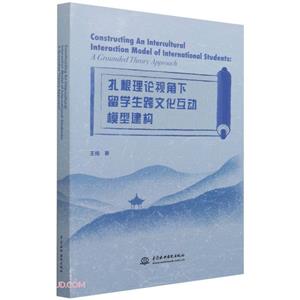扫一扫
关注中图网
官方微博
本类五星书更多>
-
>
心灵元气社
-
>
县中的孩子 中国县域教育生态
-
>
(精)人类的明天(八品)
-
>
厌女(增订本)
-
>
这样学习才高效/杨慧琴
-
>
心理学经典文丛:女性心理学
-
>
中国文化5000年
扎根理论视角下留学生跨文化互动模型建构 版权信息
- ISBN:9787517097068
- 条形码:9787517097068 ; 978-7-5170-9706-8
- 装帧:一般胶版纸
- 册数:暂无
- 重量:暂无
- 所属分类:>>
扎根理论视角下留学生跨文化互动模型建构 内容简介
随着中国经济的快速发展和国际影响力的提高,中国政府为来华留学生提供多种不同的奖学金,来华留学生数量不断上升,尤其以学位生为甚。有关在华留学生的现有研究大多从心理学角度或是影响跨文化适应的多种因素之间关系的探究,较少从认知的跨文化差异、跨文化适应中挑战的多样性以及应对措施的多元性等视角出发,对来华留学生跨文化适应的动态过程进行详尽和深度的描述。本研究旨在发现在学术和社会情景下在华留学生适应方面面临的问题和挑战,并以扎根理论为基础,构建跨文化互动模型,为来华留学生的跨文化适应提供理论指导。
扎根理论视角下留学生跨文化互动模型建构 目录
ABSTRACT
ACKNOWLEDGMENTS
List of Figures
List of Tables
Chapter 1 Introduction
1.1 Background of Internationalization of Higher Education (IHE)
1.2 Background of IHE in China
1.3 Profiles of International Students in China
1.4 Research Questions
1.5 Organization of the Book
Chapter 2 Literature Review
2.1 Cultural-General Assimilator Frameworks
2.2 Intercultural Adiustment Models
2.2.1 Model of the Acculturation Process (Ward, 1996)
2.2.2 Model of Cross-Cultural Expertise Development (Bhawuk, 1998/2009)
2.3 Research on Coping Strategies
2.4 Research on the Study of International Students in China
2.5 Research on the Study of Intercultural Interactions in Shanghai
Chapter 3 Research Design and Methods
3.1 Grounded Theory Method (GTM)
3.1.1 An Overview of Grounded Theory Method (GTM)
3.1.2 Philosophical Assumptions of Grounded Theory Method
3.2 Research Design
3.3 Research Methods and Procedure
3.3.1 An Overview of the Procedure
3.3.2 Description of the Procedure
3.4 Reliability and Validity
Chapter 4 Three Rounds of Study: Procedures, Data and Findings
4.1 Overview
4.2 Round One: Exploring Stressful Interactions and Issues
4.2.1 Sampling
4.2.2 Data Collection Procedures
4.2.3 Data Analysis
4.2.4 Initial Findings
4.2.5 Discussion
4.2.6 Model Formation
4.3 Round Two: Examining Issues and Coping Strategies
4.3.1 Sampling
4.3.2 Data Collection Procedures
4.3.3 Data Analysis
4.3.4 Expanded Findings
4.3.5 Discussion
4.3.6 Model Extension
4.4 Round Three: Eliciting Cognitive and Affective Processes
4.4.1 Sampling
4.4.2 Data Collection Procedures
4.4.3 Data Analysis
4.4.4 Extended Findings
4.4.5 Discussion
4.4.6 Model EnrirhmPnt
Chapter 5 Integration and Model Development
5.1 Summary of Research Findings
5.1.1 Correspondence of Study Themes to the Themes from Cushner and Brislin
5.1.2 Discussion of Specific Issues Related to the Theroes
5.1.3 Correspondence of Study Themes to the Culture Specific Themes
5.1.4 Other Developed Themes Related to Coping Process
5.2 Development of an Intercultural Interaction Model
Chapter 6 Conclusion
6.1 Main Findings and Significance
6.1.1 Identifying Issues and its Related Factors
6.1.2 Confirming Coping Behaviors and Strategies
6.1.3 Developing Cases for Current and Future Analysis
6.1.4 Proposing an Intercultural Interaction Model
6.2 Theoretical Implications for Intercultural Adjustment and Education Research
6.3 Practical Implications for Educators, Practitioners, and International Students
6.4 Limitations of the Study
6.5 Future Research
References
Appendix One Codebook for Participants
Appendix Two Interview Protocol for Round One
Appendix Three Sample Interview Transc ripts Coding
Appendix Four The Remaining Five Cases from Round One
Appendix Five Interview Protocol for Round Two
Appendix Six The Remaining Five Cases from Round Two
Appendix Seven The Updated Fou r Cases from Round One
Appendix Eight Interview Protocol for Round Three
Appendix Nine Examples of Fi rst Cycle Coding
Appendix Ten Examples of Second Cycle Coding
Appendix Eleven The Other Th ree Cases from Round Three
ACKNOWLEDGMENTS
List of Figures
List of Tables
Chapter 1 Introduction
1.1 Background of Internationalization of Higher Education (IHE)
1.2 Background of IHE in China
1.3 Profiles of International Students in China
1.4 Research Questions
1.5 Organization of the Book
Chapter 2 Literature Review
2.1 Cultural-General Assimilator Frameworks
2.2 Intercultural Adiustment Models
2.2.1 Model of the Acculturation Process (Ward, 1996)
2.2.2 Model of Cross-Cultural Expertise Development (Bhawuk, 1998/2009)
2.3 Research on Coping Strategies
2.4 Research on the Study of International Students in China
2.5 Research on the Study of Intercultural Interactions in Shanghai
Chapter 3 Research Design and Methods
3.1 Grounded Theory Method (GTM)
3.1.1 An Overview of Grounded Theory Method (GTM)
3.1.2 Philosophical Assumptions of Grounded Theory Method
3.2 Research Design
3.3 Research Methods and Procedure
3.3.1 An Overview of the Procedure
3.3.2 Description of the Procedure
3.4 Reliability and Validity
Chapter 4 Three Rounds of Study: Procedures, Data and Findings
4.1 Overview
4.2 Round One: Exploring Stressful Interactions and Issues
4.2.1 Sampling
4.2.2 Data Collection Procedures
4.2.3 Data Analysis
4.2.4 Initial Findings
4.2.5 Discussion
4.2.6 Model Formation
4.3 Round Two: Examining Issues and Coping Strategies
4.3.1 Sampling
4.3.2 Data Collection Procedures
4.3.3 Data Analysis
4.3.4 Expanded Findings
4.3.5 Discussion
4.3.6 Model Extension
4.4 Round Three: Eliciting Cognitive and Affective Processes
4.4.1 Sampling
4.4.2 Data Collection Procedures
4.4.3 Data Analysis
4.4.4 Extended Findings
4.4.5 Discussion
4.4.6 Model EnrirhmPnt
Chapter 5 Integration and Model Development
5.1 Summary of Research Findings
5.1.1 Correspondence of Study Themes to the Themes from Cushner and Brislin
5.1.2 Discussion of Specific Issues Related to the Theroes
5.1.3 Correspondence of Study Themes to the Culture Specific Themes
5.1.4 Other Developed Themes Related to Coping Process
5.2 Development of an Intercultural Interaction Model
Chapter 6 Conclusion
6.1 Main Findings and Significance
6.1.1 Identifying Issues and its Related Factors
6.1.2 Confirming Coping Behaviors and Strategies
6.1.3 Developing Cases for Current and Future Analysis
6.1.4 Proposing an Intercultural Interaction Model
6.2 Theoretical Implications for Intercultural Adjustment and Education Research
6.3 Practical Implications for Educators, Practitioners, and International Students
6.4 Limitations of the Study
6.5 Future Research
References
Appendix One Codebook for Participants
Appendix Two Interview Protocol for Round One
Appendix Three Sample Interview Transc ripts Coding
Appendix Four The Remaining Five Cases from Round One
Appendix Five Interview Protocol for Round Two
Appendix Six The Remaining Five Cases from Round Two
Appendix Seven The Updated Fou r Cases from Round One
Appendix Eight Interview Protocol for Round Three
Appendix Nine Examples of Fi rst Cycle Coding
Appendix Ten Examples of Second Cycle Coding
Appendix Eleven The Other Th ree Cases from Round Three
展开全部
扎根理论视角下留学生跨文化互动模型建构 作者简介
王绚,女,中共党员,上海外国语大学博士,讲师。主要研究方向为跨文化交际,在本领域发表文章10余篇,CSSCI期刊论文两篇,参与省级及厅级项目10余部,参编论著3部。2005年澳大利亚悉尼大学硕士毕业后,开始在华北水利水电大学工作。2009年赴古巴哈瓦那大学学习西班牙语,2014年上海外国语大学访问学者,2015年开始在上外攻读博士,2017年赴美国夏威夷大学访学。2019年取得博士学位。同年,应学校选派,赴北京水利部宣传教育中心挂职锻炼。
书友推荐





















